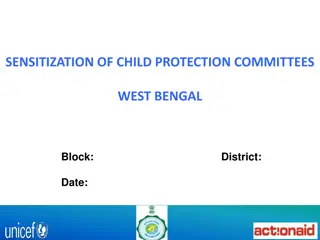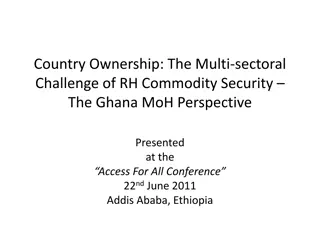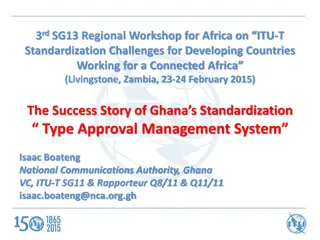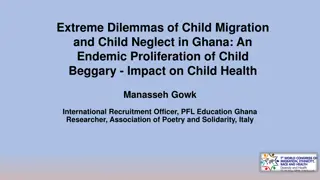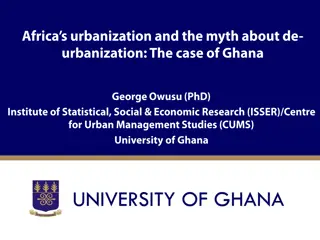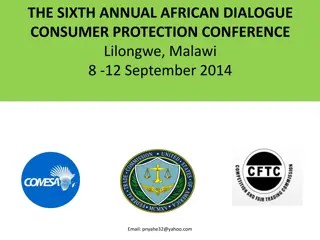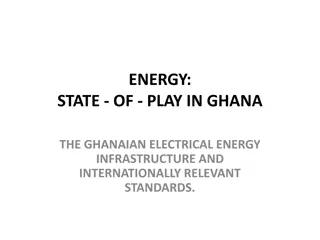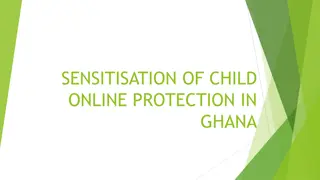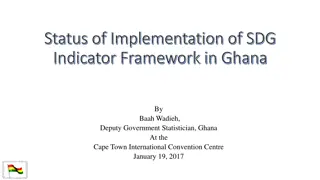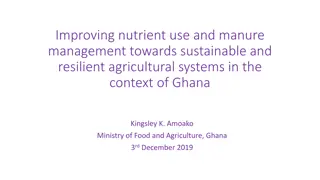Child Protection in Ghana: Overview and Challenges
Child protection in Ghana encompasses policies, strategies, and laws aimed at safeguarding children from abuse, neglect, and exploitation. This includes addressing issues such as corporal punishment, child trafficking, and child labor. Despite efforts, challenges persist, including poverty and societal norms affecting protective systems.
Download Presentation

Please find below an Image/Link to download the presentation.
The content on the website is provided AS IS for your information and personal use only. It may not be sold, licensed, or shared on other websites without obtaining consent from the author.If you encounter any issues during the download, it is possible that the publisher has removed the file from their server.
You are allowed to download the files provided on this website for personal or commercial use, subject to the condition that they are used lawfully. All files are the property of their respective owners.
The content on the website is provided AS IS for your information and personal use only. It may not be sold, licensed, or shared on other websites without obtaining consent from the author.
E N D
Presentation Transcript
1 Draft Toxicological Review of t-Butanol: Mode of Action for Thyroid Follicular Cell Tumors Public Comment: LyondellBasell James S. Bus PhD, DABT, ATS, Exponent, Inc. IRIS Public Science Meeting. June 29-30 Arlington, VA
2 Key Uncertainty Not Considered: Excessively High Top Dose in Mouse Bioassay Exceeded Limit Dose Top doses in NTP (1995) mouse drinking water bioassay: Males: 2070 mg/kg/day; Females: 2110 mg/kg/day Females: only top dose was statistically significant by pair-wise comparison; positive trend test likely dependent on high dose Males: no pair-wise comparison was statistically significant but EPA reported statistical significant trend test. EPA guidance on dose selection for animal bioassays - Limit Dose: The highest dose tested need not exceed 1,000 mg/kg/day. (EPA 870.4300, Combined Chronic Toxicity/Carcinogenicity, 1998) Both male and female top dose exceeded Limit Dose by 2-fold, questioning dose-relevance of thyroid tumor findings
3 Key Uncertainty Not Considered: Excessively High Top Dose in Mouse Bioassay Exceeded Metabolic Saturation TBA is metabolized by CYP450 that is likely subject to saturation in rats and mice, resulting in potential dose-dependent onset of nonlinear toxicokinetics Nonlinear toxicokinetics has been demonstrated in mice at dose(s) less than high dose in TBA bioassay (M = 2070; F = 2110 mg/kg/day) Dose (ip) (mg/kg) 370 741 1482 4X Fold increase (Dose) 1X 2X TBA AUC (mmol*hr/L) 28 96 324 Fold increase (AUC) 1X 3.4X 11.6X Faulkner & Hussain. Res Commun Chem Path Pharmacol 64: 31-39 (1989)
4 Toxicity Observed Above Metabolic Saturation: Lack of Quantitative Human Relevance Changes in toxicokinetics with increasing dose may result in important differences between high and low dose levels in disposition of the agent or generation of its active forms. These studies play an important role in providing a rationale for dose selection in carcinogenicity studies. (EPA Cancer RA Guidelines, 2005) Available toxicokinetic data (ADME) should always [emphasis added] be taken into account when selecting dose levels for a chronic toxicity or carcinogenicity study Many toxicokinetic processes influencing absorption, distribution, elimination and metabolic activation or detoxication may become saturated at higher doses, resulting in systemic exposures to parent compound or metabolites that would not be expected in the real life human exposures for which risk assessments are needed. (OECD Guidance Document 116 on the conduct of chronic toxicity and carcinogenicity studies, 2012)
5 Toxicity Observed Above Metabolic Saturation: Lack of Quantitative Human Relevance Although top dose selection based on identification of inflection points in toxicokinetic nonlinearity may result in study designs that fail to identify traditional target organ or body weight effects, it must be appreciated that metabolic saturation in fact represents an equivalent indicator of biological stress. In this case, the stress is evidenced by appearance of non-linear toxicokinetics rather than appearance of histological damage, adverse changes in clinical chemistry, haematology parameters or decrease in body weight gain. (OECD Guidance Document 116)
6 Impact of High Dose & Toxicokinetic Considerations on Uncertainty of Mouse Thyroid Tumors If 1995 TBA bioassay was designed according to current dose selection guidance of EPA and OECD, mouse thyroid tumors likely would not have emerged as a significant cancer concern.





